Do you like to an easy flow throughout your homeschool day with direction and purpose? Most of us do – the less stress and anxiety the better, if you ask me. And one of the best ways to get this seamless flow to your homeschool is by knowing there are various types of homeschool methods styles or approaches you can use as jumping off points.
Also known as homeschool styles, homeschool methods is basically just a natural way you homeschool, like a homeschool philosophy. It’s your natural approach to homeschooling. It’s a homeschool philosophy that resonates with you and your family.
For example, some homeschool families like to focus on hands-on activities. Some like to educate via unit studies. Others like to place an emphasis on nature and dictating. As you can see, there are different approaches to how you can homeschool your family. And I bet there’s a few in this list that you feel fits the best for you and your family, or maybe it’s even your ideal homeschool setting. Let’s see!
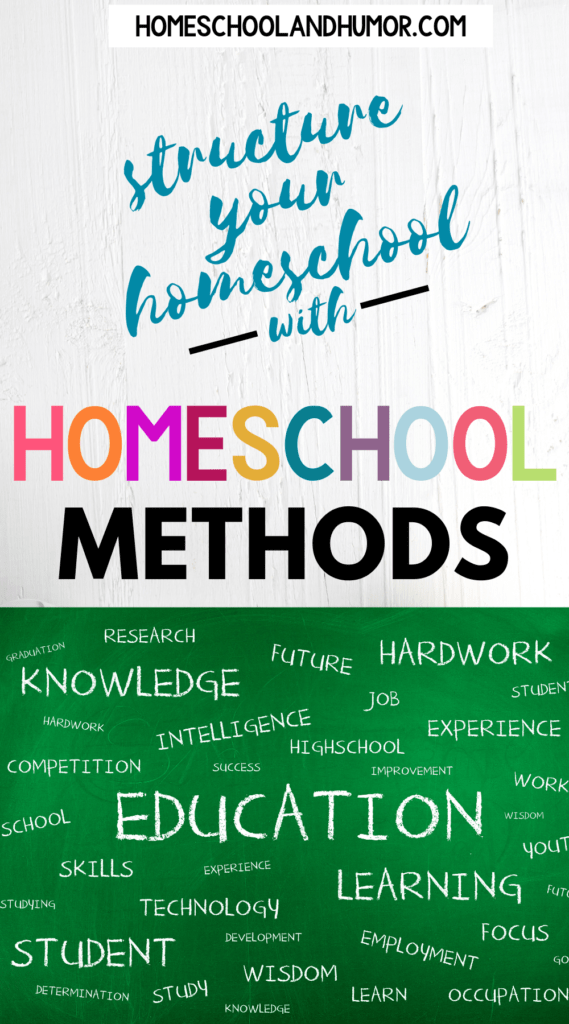
Quick Navigation
Homeschooling Methods Styles. Also known as Methods of Homeschooling (or homeschool methods) and Homeschool Approaches
Now there are a few things about homeschool approaches. There’s a ton of good things about it: you have the ultimate flexibility, control, and freedom to set your homeschooling up just the way that fits your family. Be this outdoor explorations all the time or reading books or even sitting at the table doing workbooks. And that’s a great thing to have, this homeschool style that dances to the same beat as your family dances to.
But there are also a few bad things about homeschool styles. For one, there are a ton, and I do mean a ton, of information out there that can just totally overwhelm you, especially when you first get started homeschooling. When I first got started, I had no idea there were so many different styles or approaches to the way a family can homeschool their children. But there is.
A great thing about this is that you do have a somewhat loose manual for homeschooling. Similar to when you because a brand new parent and your parenting manual were more or less What To Expect When You’re Expecting by Heidi, homeschool also as a manual – more or less – that can steer the direction of how your homeschool days will be.
How do you determine the direction of your homeschool? What is the overall tone and ideals of your homeschool? What do you want it to look like? There are a few variables to consider when homeschooling, and it all depends on which style/approach resonates with you and your family best.
Just know that homeschooling does not have to look like school at home. You do not have to mirror how the school system educates children. You can educate your children in various ways and have nothing look like school at home!
When you have a certain style to base your homeschool upon, it makes doing all that planning and preparations so much smoother. It becomes easier to plan for your days because you know how you will teach each subject and how to tackle your day. It gives you the opportunity to run your homeschool in ways that are meaningful to you and your kids, that impacts your family in most, and aligns with your own homeschool philosophy.
In this quick guide, I’m going to walk you through the various methods of homeschooling so you can let go of the other information that might have you confused.

What are Homeschool Methods or Styles?
You might choose one particular method to homeschool, but it could easily change (a few times) through the years. This is because just like everything else, even the seasons of your homeschool also changes. What worked well for one year may not work next year. Kids change, attitudes and behaviors change, us homeschool moms change, and heck even our beliefs may change.
You may also decide to cherry-pick the aspects of many of these methods to create your own unique homeschool style, which is totally cool. This is called eclectic homeschooling and in fact, it’s what I do right now. I love the capability to customize our homeschool that fits best with our family.
You can also decide which method works best for your family by knowing which learning styles your kids have.
So these approaches we’re about to jump into doesn’t mean you have to go by them, however, you may find that you do like everything about a method more than the others. If that’s the case, you’ve found the approach or style, or method that resonates with you the most. And you should adopt these aspects of the approach in your homeschool so that your homeschool flows exactly as you want it to.
Common Homeschool Methods
One way to measure these different approaches or homeschool styles, is by how each one is structured. One may be structured on more of a strict philosophy while another is extremely loosey goosey. Whichever one fits with your lifestyle is the way to go. There’s no right or wrong approach here!
1. Unit Studies Homeschool Approach
Everyone is taught all together using a theme and this theme may be topical, like the American Revolution, or a characteristic, like integrity. Many times a unit study is based on topics or books, or literature. (Like Tuck Everlasting, Sarah, Plain and Tall, or Little House on the Prairie.)
Families may use the whole school year to do one long unit study or they may want to do many smaller unit studies throughout the year.
Usually, most subjects are taught through the unit study by doing various activities. Subjects are covered within this unit study such as reading, spelling, writing, science, history, geography, math, vocabulary, geography, and fine arts. And Bible. And whatever other subjects you want to include.
For instance, in a unit study about the New World Explorers, you could:
- do geography by tracing the different voyages of each explorer,
- write a paper about all the explorers,
- learn exploration vocabulary (like navigation, magnetic, compass, caravel, etc.),
- read a book about one of the explorers like Leif the Lucky by Ingri and Edgar Parin D’Aulaire,
- compare the various timelines to that in the Bible,
- learn the history of the explorers and why it’s important today,
- do a craft about what each explorer is famous for,
- calculate the different miles of each explorer, total miles they traveled, and how long it took different ones to travel in their voyages

2. Charlotte Mason Homeschool Approach
The Charlotte Mason method was founded by Charlotte Mason back in 1892 back when homeschooling wasn’t a popular option for education. She believed all kids deserved an education regardless of rank or societal status. Her philosophy and principles are outlined in several of her books. These books really make you understand the depth of this particular method in language that you can hardly help agreeing with!
The entire method is based on Charlotte Mason’s 20 Principles and it is through these principles that educators follow accordingly.
Centering around literature books, more specifically living books, is the core of a Charlotte Mason education. Instead of using a textbook, this method uses stories about events that enable the child to be there.
For example, instead of reading about Vikings in a textbook and going over their many aspects, Charlotte Masoners will read the living book called Leif the Lucky, which tells the story of Viking explorers and how Leif Erikkson discovered North America way before Christopher Columbus did.
Young children don’t read these living books, however. A parent reads the book to the children, but only in short increments, and the children will narrate back what they heard. All lessons are about 10 minutes long because Mason believes that children will soak up and learn a small amount of information daily much more effective than a larger amount of information over the same timeframe.
She also focuses heavily on training habits of the home and education and oftentimes speaks of the parent leading by example for the children. Actually, training habits, such as diligence and attentiveness, make up a whopping 33% of a child’s education in the Charlotte Mason method.
Other areas of a Charlotte Mason education also focuses heavily on a broad liberal arts education, such as nature study, picture study, music, and a lot of time is spent outdoors.
3. School-At-Home (or Curriculum-In-A-Box) Homeschool Method
Upon our first year of homeschooling, I didn’t even really know what homeschooling actually was. We used K12, a curriculum in a box, to homeschool the kids. In fact, I thought homeschooling was K12! I also imagined our homeschool setting looking just like a public school setting.
I figured that was homeschooling. It didn’t even occur to me that homeschooling could look different than school-at-home.
There’s a learning curve to homeschooling when you’re a new homeschooler. And school-at-home may be the most familiar method of all these methods, but it definitely demands a lot of time, especially when you have multiple children.
With the school-at-home method, a textbook and/or workbook is often used for each subject. Kids sit down going through the textbook all year until they complete the textbook. The homeschool mirrors the public school’s way of education.
School-At-Home is also called curriculum-in-a-box, or school-in-a-box, because you get all of your school curricula from usually one company. The company often includes textbooks, workbooks, and school supplies within their curriculum, and many use an online component for lessons or further learning practice.
Take K12, for example. They are a school-in-a-box. I got placed an order for each grade and was shipped 4 gigantic boxes full of everything they needed for the year. I’m talking textbooks, student workbooks, teacher books, lesson plans, math manipulatives, login information, answer keys, maps, posters, learning tools… I mean EVERYTHING.
Many of the lesson plans and attendance were accessible within the online dashboard. And many subjects mixed both physical workbooks with online lessons and practice. Many subjects include cute online practice, such as cute phonics games or spelling games or math games, in addition to your textbooks.
Because this curriculum is extremely teacher/parent-intensive (meaning my involvement with teaching the subjects to the children was nearly the entire time without independence or an online computer lesson teaching them everything), there was a lot of work to be done for a school day.
You would need to organize all your material first (after checking you have everything once it all ships). Then you’re usually left with stacks of books for each subject. Sometimes four (4) books for one subject, such as a student workbook, teacher’s guide. textbook, and test book or answer key. Do 4 books for every subject and you have a ton of homeschool inventory. And that’s for one child.
However, you have everything you need in a curriculum-in-a-box method. You have all the lesson plans done for you so you know exactly what to do each day. Usually, the teacher’s guides are scripted, too, which means you know exactly what to say as well as how to teach the concepts. You don’t have to figure out what to do each day or how to go about teaching a topic or which activities to include, etc. But you will need to know which subjects to do in order that best fits your family.
One thing about a school-in-the-box, though, is that it’s a hit or miss with your child. Your child could have a strict learning style that opposes the structure of the curriculum-in-a-box, which means their grasp of learning the material is going to be hard-pressed. And you, as the teacher, are going to have a difficult time trying elaborating on concepts in order for your kiddo to connect the dots. So much research is necessary when considering a school-in-the-box method.
And even though, in my opinion, using this method is overwhelming for a new homeschooler because of all the material, now that I have some homeschool years’ worth of experience under my belt, I would still consider going back to K12 or another school-in-the-box curriculum because of all the pro’s I mentioned. They were a great program for the kids and cut preparation time on my part down to a minimum.
Just keep in mind that the School-In-The-Box homeschool method – or the curriculum-in-a-box method – is usually the most expensive method out there. Saying that though…I’ve seen curriculums that aren’t school-in-the-box that are quite pricey too. They sure are proud of their curriculum!
4. Classical Homeschool Method
The classical homeschool method always makes me think of classical music. I don’t know why. Ha! Perhaps it’s because it focuses on the conscious mind, and both the classical method and classical music wraps around your mind and way of thinking.
Which is the focus of the classical method: teaching your child how to learn rather than what to learn.
The method can be broken down into two different types of classical homeschooling, but I like to keep things simple, so I’m not going to dive into those. If you want to learn more about classical homeschool methods, you can check out The Well-Trained Mind, by Dr. Susan Wise Bauer, who is a well-known homeschool mom that advocates the classical homeschool method and the creator of a few classical curriculums.
You could also visit ClassicalCurriculum.org as it goes in-depth about the classical homeschooling method and helps you out on different aspects that could best suit your family and teaching styles. After all, we all want to emulate our homeschooling into what we see in our mind’s eye, and that picture in your mind is what is probably your ideal homeschool setting.
And if you want your curriculum to be historical-based, perhaps a classical curriculum is what you see in your mind when you think of the ideal homeschool for your family. The classical approach has the worthy overall goal of teaching children to think for themselves. Using the “trivium” model, children move through three main stages of learning: concrete learning (the grammar stage), critical learning (the logic stage), and abstract learning (the rhetoric stage).
If you want to dive further into the Classical homeschool method / model, I encourage you to read The Well Trained Mind’s A Guide to Classical Education at Home by Susan Wise Bauer and Jessie Wise. This book will open your eyes to the philosophies of implementing a classical education into your homeschool. Trust me, you’ll learn TONS from this book!
5. Unschooling Homeschool Method
Unschooling is a relaxed approach to homeschooling as you study what your child is interested in.
It generally means learning without prescribed lessons, textbooks, or the school-like methods many other homeschoolers use. You know how we talked about a curriculum-in-a-box laying everything out for you? Well, the unschooling method is quite the opposite – it’s a child-led method, an interest-led method. What the child is interested in learning, that’s what you teach and what your homeschool day will be about.
Children also choose how they want to study these interests. If they don’t want to study math, you don’t study math. Or if they want to learn more about the indigenous people, you learn about the indigenous people. If your child does not want to do hands-on activities, you don’t do it.
There is no formal curriculum for the unschooling method, but many parents claim that this works for their family. I personally have never been an Unschooler, though we do incorporate interests into our everyday homeschool. We use unit studies for this, though. That’s not the same thing as unschooling because I decide, most of the time, how we’ll learn about a topic.
The Unschooling method was founded by John Holt who said, “allowing children as much freedom to learn in the world as their parents can comfortably bear”. Like Jesus, Unschooling has many names: natural learning, child-led learning, interest-led learning, or self-directed learning.
The focus of the Unschooling homeschool method is nurturing a love of learning through a child’s natural curiosity. And because a child is studying what his or she is interested in, they will usually retain this newly-learned, child-interested information.
6. Montessori Homeschool Method
With a Montessori homeschool, the child directs the learning. Parents facilitate their child’s education by connecting materials and curricula with each child’s interests. They also create a prepared environment that encourages students to explore and discover.
The Montessori method was founded my Maria Montessori, a medical doctor and Italian educator in the late 19th and early 20th century who focused her attention on how young children learn. Her findings led to an educational philosophy that revolutionized early childhood education and continues to influence preschools, daycares, church schools, and homes to this day.
Montessori-inspired curriculums usually involve hands-on activities, since the focus is to discover and explore. You will find several different curriculums available that are geared towards this method, where kids will be actively involved in their education. They set up the learning activities, or centers, and the children decide which activities they want to do.
The parents are also role models of how they want the children to be. Learn by example, type of thing. The Montessori approach also focuses on positive behavior and conflict resolution. Having a predictable daily routine is also important for the Montessori approach.
There are several homeschoolers who implement this Montessori style learning in their homeschools. You can also find many local schools, possibly even around your area, that are set up as Montessori schools, with “Montessori” right in the name of the school.
Of course, there are tons more information on the Montessori method of homeschooling than I can dish out. Which is why, if you are interested in this type of homeschool method, or want to implement some of its characteristics into your homeschool, you should read this book about the Montessori method by Maria Montessori herself:
There are two other books by Maria Montessori that are also interesting and explains the Montessori method further:
7. Eclectic Homeschool Method
The final homeschool method, and alas my favorite and personal method, is the Eclectic homeschool method. This method combines various approaches and methods to teach the objectives of the courses and lessons. It’s also known as mixed-methods.
To sum it up in even simpler terms, the eclectic method takes a little bit from the Charlotte Mason method – if you want to – and takes a little bit of the Montesorri method – if you also want to – and maybe throws in a unit study or two, and there you go. There’s your personal method.
This method is how you can truly customize your homeschooling though. For me, I take what I deem are the best parts of all these methods mentioned and I use these “best parts” in my homeschool.
After I’ve learned what my child’s learning style is, that is. So based on my kids’ learning styles, I customize their education accordingly. And sometimes it’s nature study with 10 minute lessons Charlotte Mason-style, and other times we’re discovering and exploring actively with hands-on learning like Montessori-style.
You don’t have to use every mix of these methods every time. We surely don’t thrive with monotony in our homeschool! We like to mix things up a bit, well, a lot! So using the eclectic approach in our homeschool is what fits best with our family. Especially since we are usually traveling and homeschooling away from home at the same time.
How To Decide Which of the Homeschool Methods Is Right For You
Which one of these approaches resonates best with you and your family? It’s always great to keep your family in mind when deciding things for your homeschool as a whole, but you also need to consider which one best resonates with you as the homeschool mom.
With that in mind, think about your family as a whole too. It’s likely that your natural rhythm has influenced your family’s natural cadence. For instance, how you have been directing the days for your family, for like ever, has most likely pushed them into a certain lifestyle, directed by you.
So if you’re a morning person, more than likely you have pushed your kiddos to wake up early since they were young. If you sleep in, you’ve probably allowed your kids to sleep in too. See what I mean? Your natural peak time of day has influenced your kids’ peaks too.
With this in mind, take the 8 common homeschool methods I outlined above. Which one do you think speaks the loudest to you about your family’s natural lifestyle affinity? There is definitely not one better than the other and for sure there’s no right or wrong selection.
That’s the thing about homeschool: you can customize it to fit your family instead of customizing your family to fit homeschooling.
And if you’re more like us, who loves something from all of the styles mentioned here, then you’re easily identified as an Eclectic Homeschooler.
If you don’t like labels, then no worries. Just don’t label it. 😉
But from an industry standpoint, that’s what you are…if you do pick a little something from all of them as we do, then you’re eclectic. But it’s not like you need to enter your homeschool style/method on an official ballot or anything. 😉
So here’s what you can do now. Take the different points in each method above, use the worksheets here to add in what you like about each homeschool method. Then tally it all up and determine what your final method is. Then take the final method and google as much information about it as possible.
Click the image below to download your free worksheet now!
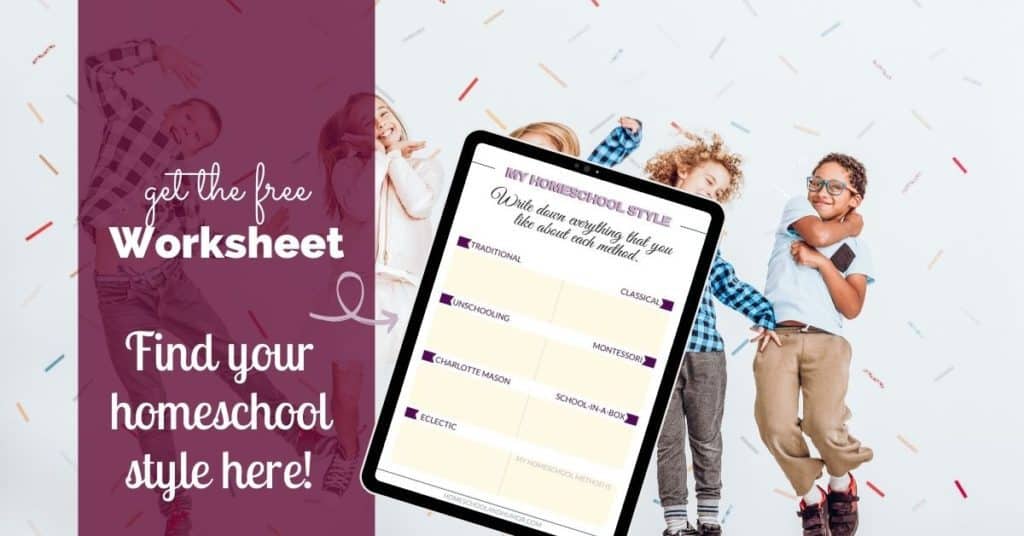
You Can CHANGE Your Homeschool Method
As a last note, I want to tell you something real and true. You will find yourself in a season during your homeschool where your methods aren’t fitting in quite as well and you need to change to a different homeschool style. I want to tell you that this is absolutely okay and normal.
A method may speak volumes to you, but another method may be pulling on your heartstrings. Go with your heart. Step back and look at the big homeschool picture here, including your kids’ contentment in that picture.
If you find yourself needing to switch your entire style of homeschooling, do it. You will be very glad that you did and the happiness all around with be overflowing.

You might be 100% a Charlotte Mason homeschooler or like how most of us started out, a traditional homeschooler, because of the familiarity of it all. But if you see struggle in the daily conundrum of life, or maybe you are at your very last straw with “this whole homeschooling thing”, then I encourage you to switch up your homeschool style.
This will happen during your homeschool throughout the years. One season of homeschool – or life – is not the same as a new season of homeschool. For us all, life happens, and that will affect your homeschool too.
Also, if you are naturally pulled to one type of homeschooling, remember that your kids are not. Not just yet anyway. If you’re new, that is, or fairly new to homeschooling.
If your kids transitioned from public school, remember that in public school, a traditional education style/method is what they are used to. However, with that said, also note if your child was thriving or struggling in public school. If this is the case, then traditional homeschooling is likely not the model for them either.
When the terrain changes, you change your shoes, right?
Let me ‘pair’ this with shoes (see what I did there?). Say you absolutely love, love, love high heels. You would wear heels everywhere if you could. Wearing high heels, walking in these high heels, feel so comfortable and natural to you. You can strut it with the best of them.
You and your family are always doing stuff, and when you do, you instinctively put on the heels. Since the fam has been quite taken with nature walking lately, every time when you guys go trail walking or hiking you naturally grab your beloved 4-inchers.
You hike with these high heels every time. And as much as you love these heels, you’re starting to feel slightly unbalanced, like maybe you should switch to a different type of shoe? A shoe that fits in with your everyday adventures and lifestyle..well, your lifestyle as it is these days, right? A shoe that will perhaps make you less uncomfortable and give you more reason to run and let loose in your day-to-day adventures (rather than doing that diva hobble version of running, you stubborn woman, you).
So you start to research boots. And how boots differ from hells when nature trailing and hiking. And you look into all about wearing boots during your daily hikes instead of high heels. Finally, you bite the bullet and you switch to boots, but not just any boots. Hiking boots.
You wear these hiking boots that very day while you go on your family’s daily adventures and, what do you know, these are like having an amazing foot massage the whole time!
You’re laughing, you’re smiling. You Feel Good. You feel so good in fact that your kids are having the best time playing with you, running around with you as you all play catch-and-tickle. Everyone’s smiling and laughing. Your kids’ eyes are sparkling because they haven’t had this much fun in forever.
With this abundant joy in everyone’s hearts, you notice the sun catching your kids’ hair just a little bit differently today. Shinier and brighter. How have you not noticed that beautiful auburn glow in your middle child’s hair before?

Perhaps you were too busy trying to stand up straight in those heels?
Changing your shoes…your method…is a brave thing, especially when you’re so used to doing something one way. Or if that one way just isn’t working, if your homeschool calls for a change, brave the change head on. You already know in your heart it will be okay.
With your kids happier than ever, and you having that steady joy in your gut, isn’t it funny how all you needed to do was change your shoes?
Reclaim Your Homeschool: Use Homeschool Methods For Your Peace of Mind
So there you have it – the most common methods of homeschooling. There could be a few more, but really, this is all you really need to be aware of to make a good, informed decision on setting the direction of your homeschool in a more structured way.
When you look more into each homeschool method, you’ll learn more and more about each one. And when you do learn more and more about each one, you’ll see the direction you want your homeschool to go.
The seven methods of homeschooling we went over were: unit study method, Charlotte Mason method, classical method, unschooling method, school-in-a-box method, Montessori method, and eclectic method.
One of these methods probably speaks to you more than the others. And there’s no right method and no wrong method. They’re all great. Now, everyone has their opinions about different methods, but none of those opinions matter when you’re looking at what’s best for your family. All of these methods have the child’s best interests at heart and I believe all of these methods are great.
What type of method are you most interested in? Do you have a preferred method of homeschooling that you use in your homeschool? If so, comment below and share! We’d love to hear about it!
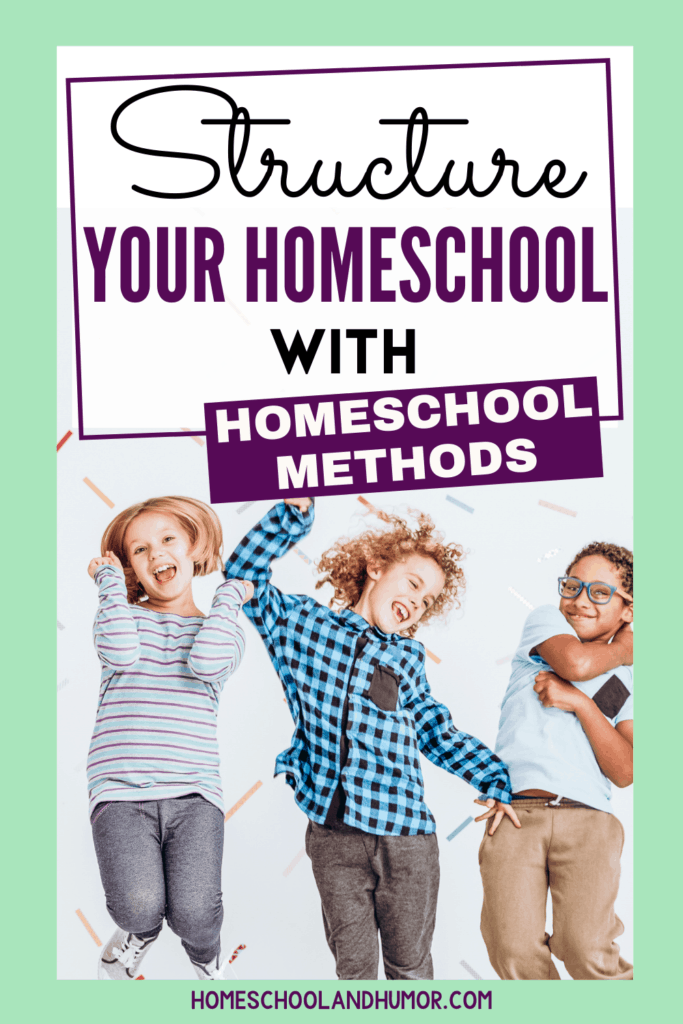
- Top 16 Indoor Games for Teens That Won’t Turn Your House into a War Zone - January 29, 2024
- Free Crafty Printable Christmas Countdown Calendars For Kids - December 17, 2023
- 12+ Very Cute Printable Christmas List Template For Kids - December 14, 2023

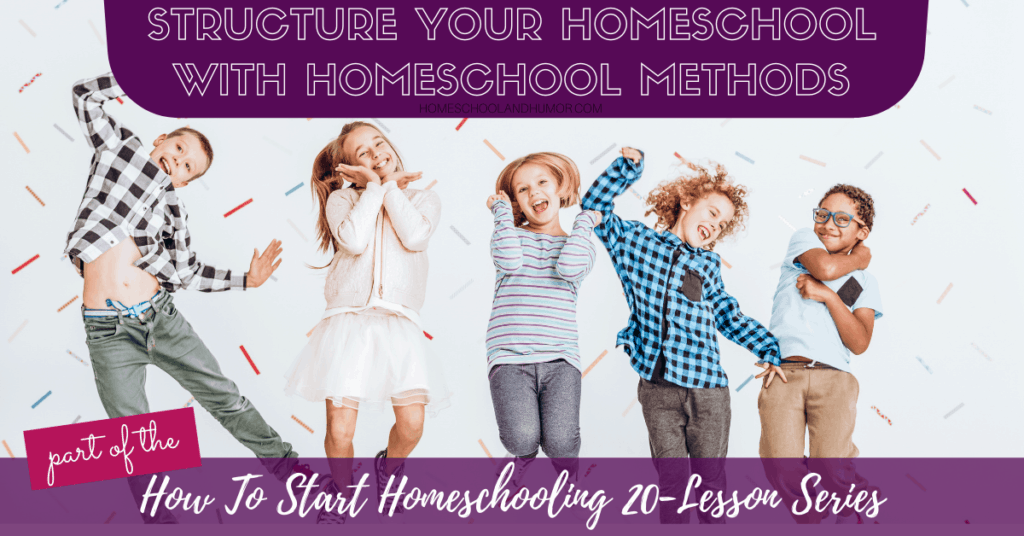








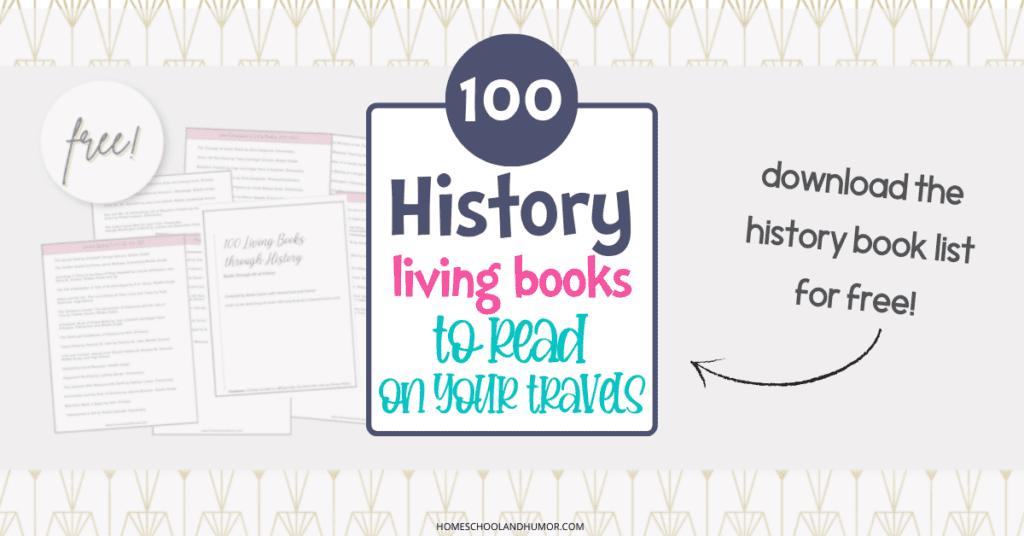
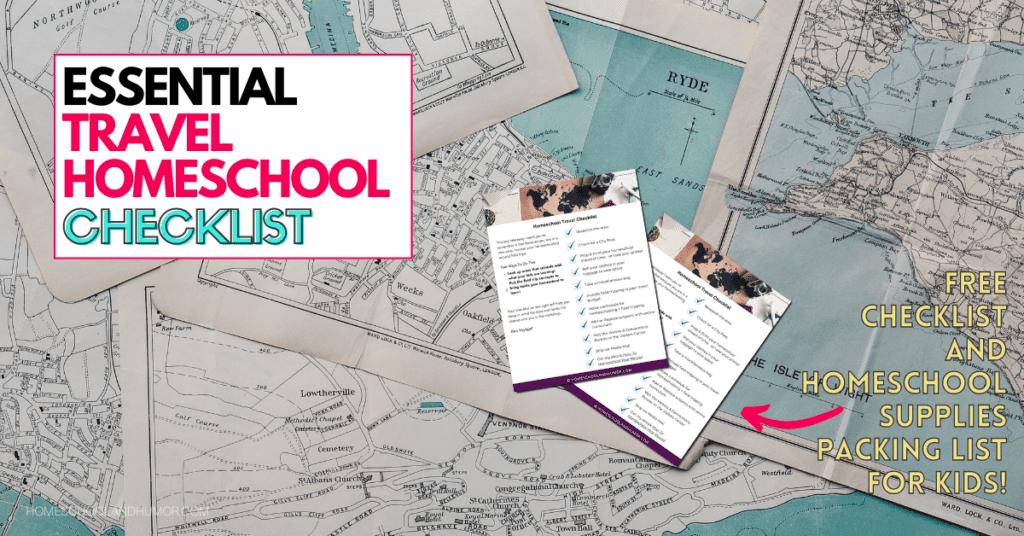
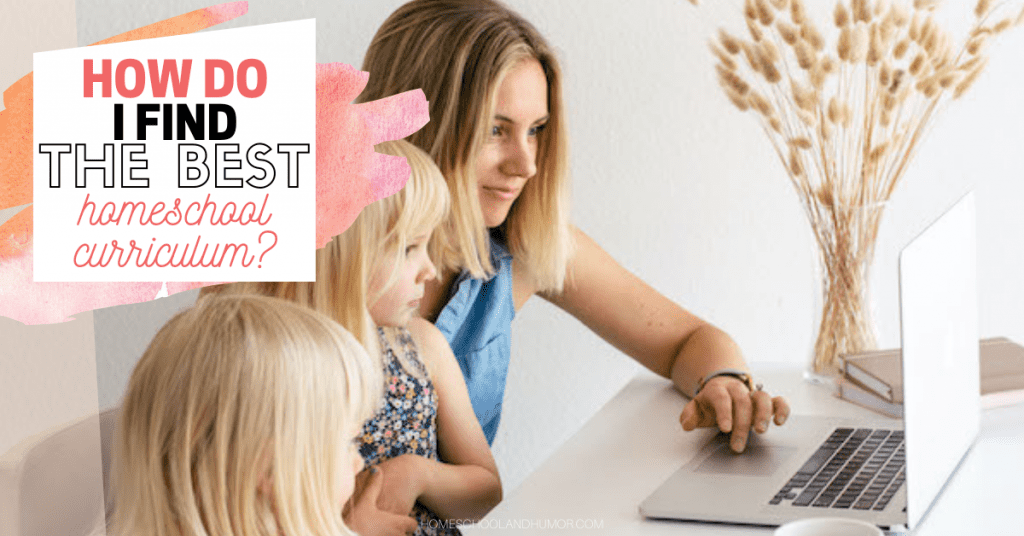


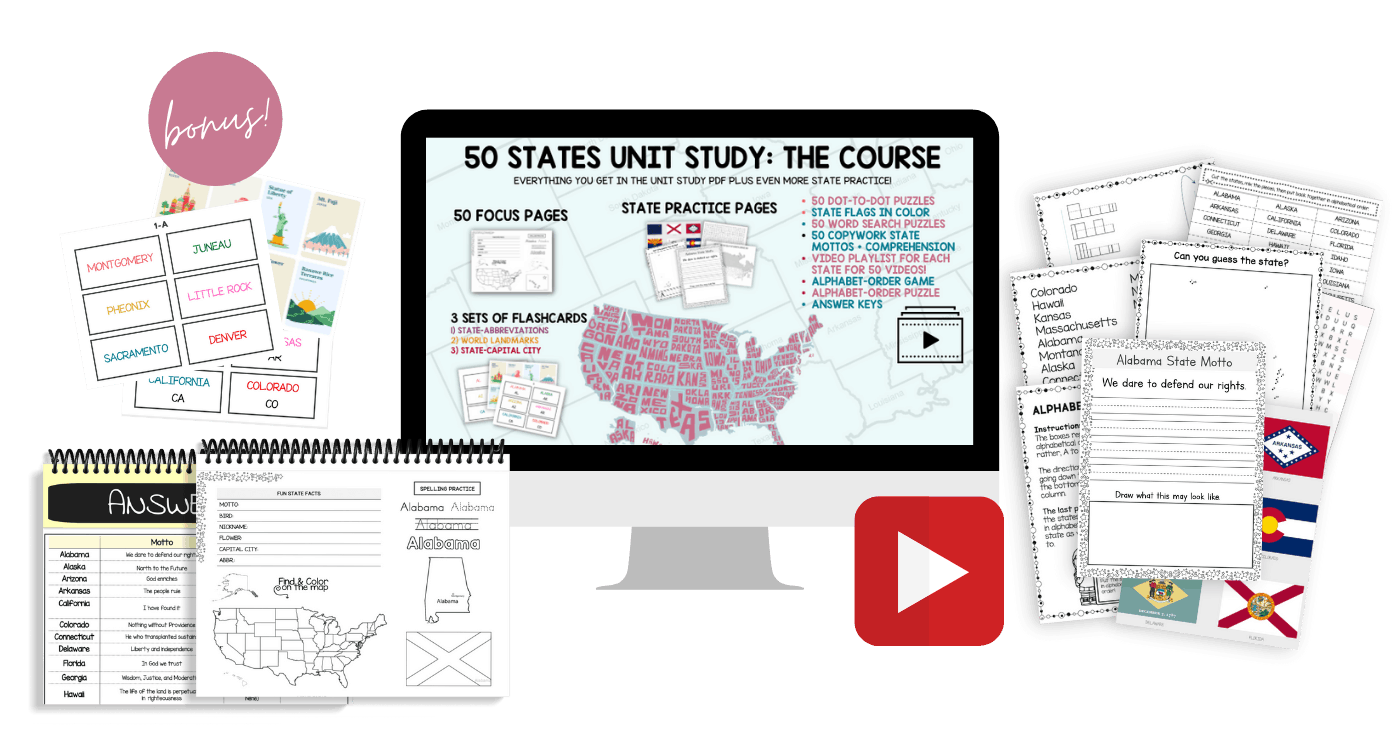

Pingback: November Home School Round Up {Homeschool Collection} - Homeschool Review Crew